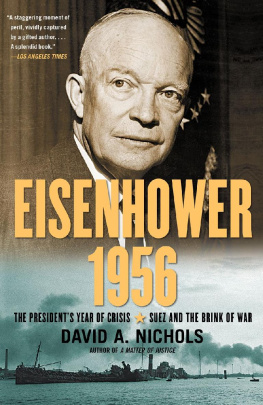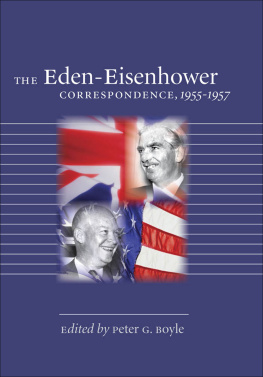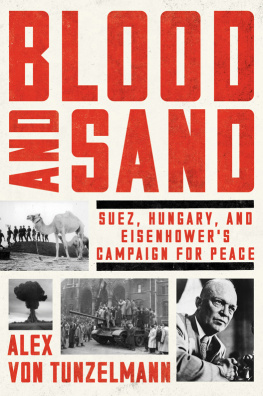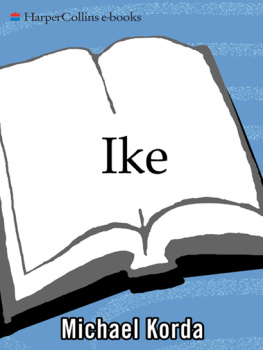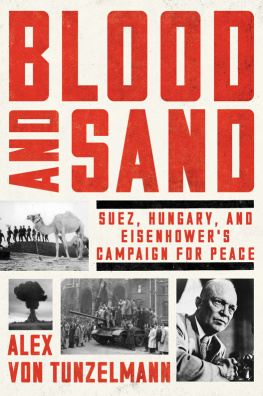ABOUT THE AUTHOR


DAVID A. NICHOLS, a leading expert on the Eisenhower presidency, is the author of A Matter of Justice: Eisenhower and the Beginning of the Civil Rights Revolution and Lincoln and the Indians. He is a veteran of thirty-five years in higher education as a professor and administrator, including eleven years as an academic dean at Southwestern College in Kansas. Nichols lives in Winfield, Kansas.

MEET THE AUTHORS, WATCH VIDEOS AND MORE AT
SimonandSchuster.com
THE SOURCE FOR READING GROUPS
COVER DESIGN BY DAVID TER-AVANESYAN COVER PHOTOGRAPHS: EISENHOWER BETTMANN/CORBIS; SUEZ CANAL POPPERFOTO/GETTY IMAGES AUTHOR PHOTO GARY E. HANNA
ACKNOWLEDGMENTS

MY MOST important acknowledgement is to Dwight D. Eisenhower himself, who insisted on the meticulous record keeping that allows me to take the reader right into his hospital room or the Oval Office. Ike resisted pressures to build his library in a metropolitan center or attach it to a university, placing it in his hometown of Abilene, Kansas, a three-hour drive from my home. The Eisenhower Librarys staff members in Abilene are the ongoing custodians of those records, so I am especially indebted to Director Karl Weissenbach, Deputy Director Tim Rives, Chalsea Millner, Catherine Cain, Kathy Struss, and Chris Abraham. I especially revere legendary archivists David Haight (who was instrumental in declassifying hundreds of documents essential to this book) and Jim Leyerzapf, both recently retired.
Three Eisenhower organizations have supported my work, including the Eisenhower Library Foundation, the Eisenhower Institute, and the Eisenhower Memorial Commission, whose director, Brigadier General Carl W. Reddel, has been particularly supportive.
Susan Eisenhower, Ikes granddaughter and a scholar in her own right, called the neglect of the Suez story to my attention. John S. D. Eisenhower, Ikes son and Susans father, provided insights about his fathers personality and ways of addressing issues. Daun van Ee at the Library of Congress, editor of the published Eisenhower papers, knows more about Eisenhower than any human being and always finds time to answer questions and provide provocative interpretations. Irwin F. Gellman, working on a multivolume biography of Richard Nixon, reviewed my work, alerted me to important sources, and offered sage advice. Dr. Michael Birkner at Gettysburg College has been an advisor and supportive colleague. George Colburn of Starbright Media Corporation has inspired my research with his videotaped interviews of Eisenhower-era personalities. Jeffrey Barlow at the Naval History and Heritage Command in Washington, D.C., advised me concerning naval maneuvers during the Suez crisis and Tim Frank facilitated my obtaining a copy of an important declassified study of the naval history of the Suez crisis.
No historian can function without the dedicated assistance of libraries and librarians. Beyond the Eisenhower Library, Nan Myers at Wichita State Universitys Ablah Library provided me with special access to the FRUS (Foreign Relations of the United States) volumes; Veronica McAsey, the director of the Southwestern College Memorial Library, afforded similar access to the Public Papers of the Presidents and other services; Princeton Universitys Seeley Mudd Library and the Dartmouth College Library provided copies of documents that saved me from time-consuming and expensive travel.
My agent, Will Lippincott of Lippincott, Massie and McQuilkin, and Roger Labrie, my editor at Simon & Schuster, have been my partners once again in producing the book. Their working relationship is something special. Labrie, a skilled wordsmith, is unusually knowledgeable about Eisenhower and a master at both supporting and prodding anxious authors to finish their tasks. I thank the Simon & Schuster leadership team who took a chance on an unknown author with my first Eisenhower book and dared to invest in another one. A special thank you to Simon & Schusters publisher, Jonathan Karp, who selected the title and has provided support to position the book to appeal to a broad audience.
Special friends include Rev. Tom Wallrabenstein, who read early drafts; the Rev. Dr. Allen Polen who freed me repeatedly from lay pastor responsibilities at Prairie View United Methodist Church (a congregation that has enthusiastically supported my work); David Seaton, the publisher of the Winfield Daily Courier , who provided sage observations that have shaped my understanding of politics; and David H. Swartz, the former ambassador to Belarus and fluent in Russian, who translated a critical message from Soviet premier Nikolai Bulganin to Eisenhower. Dr. Carl E. Martin, my former president and college classmate, has been an enthusiastic advocate for my post-retirement career as a historian and Dr. W. Richard Merriman, Jr., current president of Southwestern College, helped me set the stage for that career and has been consistently supportive.
Above all there is Grace, the most devoted and helpful partner a man could hope for. She has proofed hundreds of drafts of the manuscript, contributed creative ideas, caught my mistakes, and provided the emotional support indispensable to the challenging task of telling the story of the Eisenhower presidency.
ALSO BY DAVID A. NICHOLS
A Matter of Justice: Eisenhower and the Beginning of the Civil Rights Revolution
Lincoln and the Indians: Civil War Policy and Politics

THE MAN AND THE MOMENT
I believed that it would be undesirable and impracticable for the British to retain sizable forces permanently in the territory of a jealous and resentful government amid an openly hostile population.
Eisenhower in his memoir, Waging Peace
DWIGHT D. EISENHOWER was sworn in as president of the United States at 12:32 P.M. on January 20, 1953. He had won the election over the Democratic candidate, Adlai Stevenson, primarily because he was an iconic war hero, associated in the public mind with victory in World War II. Elliot Richardson, a war veteran who later led four different cabinet-level departments, sensed Ikes mettle as a crisis leader the first time he saw him. Richardson said to himself: This guy is a tough son-of-a-bitch!
Yet, on Inauguration Day, Eisenhower avoided the grand gestures or dramatic rhetoric one might have expected from a flamboyant military figure like Douglas MacArthur. He flashed the famous smile only once during the ceremony. The New York Times described his demeanor as grave and grim, saying he looked lonely and a little sad as he assumed a responsibility no one can bear without trembling. Begun with a prayer, Eisenhowers inaugural speech was a serious, almost philosophical dissertation
Columnist James Reston noted that forty-one of the forty-eight paragraphs in the speech were devoted to foreign affairs. Eisenhower assured the nations in major regions of the worldEurope, the Far East, and Latin Americaof American support in their quest for freedom. He did not mention the Middle East. Listening to Eisenhowers inaugural address, Reston tried to discern whether the general was a Europe-firster or an Asia-firster. On January 20, 1953, no one thought to ask whether Ike was a Middle Eastfirster.

